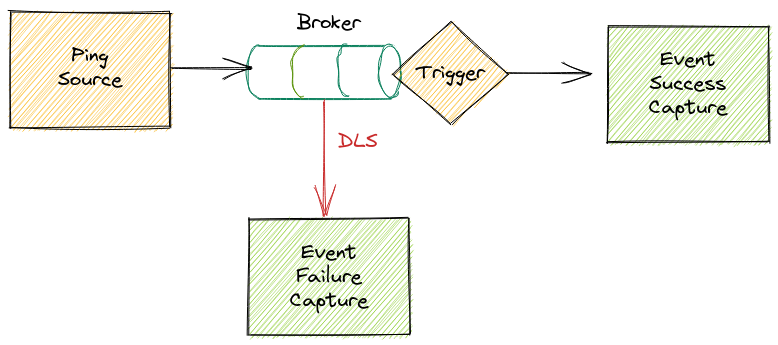Creating a Bridge With a Dead Letter Sink (DLS)
What is a Dead Letter Sink?
A Dead Letter Sink is a Knative construct that allows the user to configure a destination for events that would otherwise be dropped due to some delivery failure. This is useful for scenarios where you want to ensure that events are not lost due to a failure in the underlying system.
Scenario Debriefing
In this example we are going to create a Bridge that contains a PingSource object that will emit an event on a regular basis to a Broker named demo. A Service, named event-success-capture will subscribe to PingSource events flowing through the Broker using a Trigger.
The Broker delivery options will be set to use a Dead Letter Sink so that in the case of a delivery error the event will be forwarded to another Service named event-failure-capture instead of being lost into the void.

We will test the bridge to make sure events are delivered to event-success-capture, then we will break the bridge by removing the event-success-capture service, in which case we expect the Dead Letter Sink to receive all events that were not delivered.
Creating a Bridge with a Dead Letter Sink
Creating objects
All objects mentioned at this guide are intended to be created at kubernetes.
When using kubectl write the provided YAML manifests to a file and write at a console:
Alternatively if you don't want to write the manifests to a file you can use this command:
Bridge manifest
The next steps configure and explain the Bridge to build to demonstrate the usage of the Dead Letter Sink. A single manifest containing all the objects in the bridge can be downloaded here.
Step 1: Create the Broker
Create a new Broker with following configuration:
apiVersion: eventing.knative.dev/v1
kind: Broker
metadata:
name: demo
spec:
delivery:
deadLetterSink:
ref:
apiVersion: serving.knative.dev/v1
kind: Service
name: event-failure-capture
backoffDelay: "PT0.5S" # ISO8601 duration
backoffPolicy: exponential # exponential or linear
retry: 2
Here a Broker named demo is configured with the following delivery options:
- 2 retries on failure, backing off exponentialy with a 0.5 seconds factor. This is not the focus of this article but it is recommended to setup retries before giving up on delivery and sending to the DLS.
- Dead Letter Sink pointing to a service named
event-failure-capture. Kubernetes can be requested the creation of this object even if the DLS service does not exists yet.
Step 2: Create the PingSource
Create a PingSource object with the following configuration:
apiVersion: sources.knative.dev/v1
kind: PingSource
metadata:
name: say-hi
spec:
data: '{"hello": "triggermesh"}'
schedule: "*/1 * * * *"
sink:
ref:
apiVersion: eventing.knative.dev/v1
kind: Broker
name: demo
This object will emit an event every minute to the Broker created in the previous step.
Step 3: Create the event-success-capture Service
Create a Service named event-success-capture with the following configuration:
apiVersion: serving.knative.dev/v1
kind: Service
metadata:
name: event-success-capture
spec:
template:
metadata:
annotations:
autoscaling.knative.dev/min-scale: "1"
spec:
containers:
- image: gcr.io/knative-releases/knative.dev/eventing/cmd/event_display
That service will write to its standard output any CloudEvent received. We will use a Trigger to subscribe to all events flowing through the Broker.
Step 4: Create the demo-to-display Trigger
Create a Trigger to route events to the event-success-capture Service with the following configuration:
apiVersion: eventing.knative.dev/v1
kind: Trigger
metadata:
name: demo-to-display
spec:
broker: demo
subscriber:
ref:
apiVersion: serving.knative.dev/v1
kind: Service
name: event-success-capture
This Trigger configures the Broker to send all flowing events to the event-success-capture service.
Step 5: Create the event-failure-capture Service
Create the Service named event-failure-capture that was configured at the Broker as the Dead Letter Sink parameter:
apiVersion: serving.knative.dev/v1
kind: Service
metadata:
name: event-failure-capture
spec:
template:
metadata:
annotations:
autoscaling.knative.dev/min-scale: "1"
spec:
containers:
- image: gcr.io/knative-releases/knative.dev/eventing/cmd/event_display
This service should only receive messages that could not be delivered to a destination.
Test the Bridge
Make sure that all created objects are ready by inspecting the READY column after this command:
$ kubectl get ksvc,broker,trigger
NAME URL LATESTCREATED LATESTREADY READY REASON
service.serving.knative.dev/event-failure-capture http://event-failure-capture.default.192.168.49.2.sslip.io event-failure-capture-00001 event-failure-capture-00001 True
service.serving.knative.dev/event-success-capture http://event-success-capture.default.192.168.49.2.sslip.io event-success-capture-00001 event-success-capture-00001 True
NAME URL AGE READY REASON
broker.eventing.knative.dev/demo http://broker-ingress.knative-eventing.svc.cluster.local/default/demo 3m20s True
NAME BROKER SUBSCRIBER_URI AGE READY REASON
trigger.eventing.knative.dev/demo-to-display demo http://event-success-capture.default.svc.cluster.local 3m20s True
Each minute a CloudEvent should be produced by PingSource and sent to the Broker, which in turns would deliver it to the event-success-capture, while event-failure-capture should not be receiving any event. We can confirm that by reading each of those services output:
Retrieving logs command
Kubernetes generates dynamic Pod names, but we can use kubectl with the -l flag to filter by a label that identifies the Service.
We also add the -f flag to keep receiving logs as they are produced, this way we can see the live feed of events arriving at the Service.
$ kubectl logs -l serving.knative.dev/service=event-success-capture -c user-container -f
☁️ cloudevents.Event
Context Attributes,
specversion: 1.0
type: dev.knative.sources.ping
source: /apis/v1/namespaces/default/pingsources/say-hi
id: efcaa3b7-bcdc-4fa9-a0b3-05d9a3c4a9f9
time: 2022-06-01T19:54:00.339597948Z
Extensions,
knativearrivaltime: 2022-06-01T19:54:00.340295729Z
Data,
{"hello": "triggermesh"}
As expected the event-success-capture is receiving events produced by PingSource.
$ kubectl logs -l serving.knative.dev/service=event-failure-capture -c user-container -f
2022/06/01 19:36:45 Failed to read tracing config, using the no-op default: empty json tracing config
Meanwhile event-failure-capture is not showing any event.
Test Failing Bridge
To make the Bridge fail will be removing the event-success-capture service. That will make the delivery fail and (after 2 retries) be sent to the Dead Letter Queue.
$ kubectl delete ksvc event-success-capture
service.serving.knative.dev "event-success-capture" deleted
After doing so, all events not delivered by Broker through the configured Trigger will be shown at the event-failure-capture:
$ kubectl logs -l serving.knative.dev/service=event-failure-capture -c user-container -f
☁️ cloudevents.Event
Context Attributes,
specversion: 1.0
type: dev.knative.sources.ping
source: /apis/v1/namespaces/default/pingsources/say-hi
id: 7e11c3ac-2b00-49af-9602-59575f410b9f
time: 2022-06-01T20:14:00.054244562Z
Extensions,
knativearrivaltime: 2022-06-01T20:14:00.055027909Z
knativebrokerttl: 255
knativeerrorcode: 500
knativeerrordata:
knativeerrordest: http://broker-filter.knative-eventing.svc.cluster.local/triggers/default/demo-to-display/bd303253-c341-4d43-b5e2-bc3adf70122a
Data,
{"hello": "triggermesh"}
Clean up
Clean up the remaining resources by issuing this command: